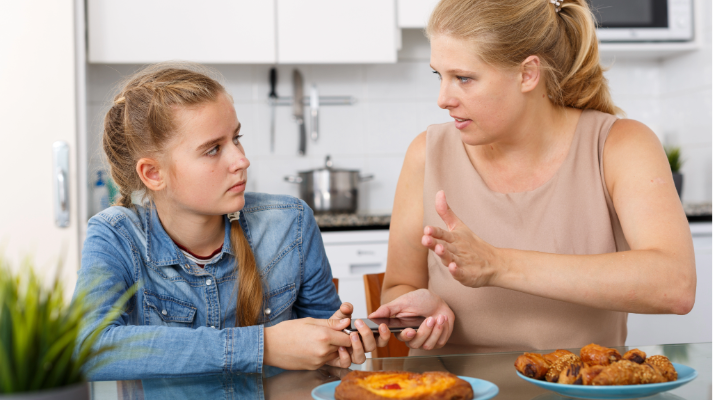By Steve and Candice Watters
This is the second in a two-part series with Clare Morell, author of The Tech Exit: A Practical Guide to Freeing Kids and Teens from Smartphones. In Part 1 of our interview with Morell, she talks about the dangers screens pose to children’s bodies, relationships, and spiritual development. Now we turn to her solution: Fasting and Feasting.
Steve Watters: We've heard various responses to the concerns you've raised about children and screens, such as implementing time limits and parental controls. In your book Tech Exit, you encourage a more significant response. Can you summarize your recommendations?
Clare Morell: First, I recommend a Fast—a digital detox for families where parents have already given screens to their kids. That’s the first step, because there’s an actual addictive component to these devices. It’s not just about taking screens away, but also having a plan to replace that time with non-screen activities. And that takes commitment.
In the book I walk parents through how to do that and share stories of families who’ve successfully taken this step. Even if they’re not sure about a long-term tech exit, almost every parent can try something for 30 days—and they may be surprised by the results and want to keep going.
But the bigger question is: How do we keep that going long-term? I use the acronym FEAST to describe how to move from a digital fast to a lifestyle of feasting on real life.
F – Find Other Families
This is critical. Every family I interviewed who successfully adopted a tech-exit lifestyle found at least one or two other families to do it with. You need allies—other parents who share your values and kids who also aren’t on smartphones. I provide examples and ideas for how to build that community.
E – Explain, Educate, and Exemplify
This is especially important for Christian families. Tech restrictions shouldn’t just be handed down like a list of rules. Parents need to explain why they’re doing this. Educate kids about the harms, and model the kind of tech use you hope they’ll adopt as adults.
There’s a myth that if you want to prepare your child to use tech wisely, you have to give it to them young. But we don’t do that with other powerful tools or substances. You don’t give a child alcohol so they’ll learn moderation—you educate and prepare them for healthy adult use. The same should apply to technology.
I encourage parents to think: Am I modeling the kind of tech use I want my kids to have? If not, something needs to change. And we also want to prepare them for real-world challenges—like what to do if a friend shows them something inappropriate on a phone. I recommend tools like the book, Good Pictures, Bad Pictures, and other age-appropriate resources to help parents explain, equip, and engage.
A – Adopt Alternatives
Many parents simply aren’t aware that there are non-smartphone options. I hear, “Well, my child is driving—they need a phone for safety.” That’s fine! But they don’t need a smartphone. There are talk-and-text-only phones, some with GPS but without internet, social media, or addictive apps.
I also acknowledge that so many activities now require apps. Some parents had to talk to coaches, teachers, or group leaders and ask for alternative ways for their kids to participate without needing a smartphone. It takes effort, but these parents were determined to find workarounds.
S – Set Screen Time & Create Accountability
This is about how families use other screens—TVs, computers, email—once smartphones and tablets are removed. I encourage families to set clear digital rules: screens should be used publicly, with purpose, and never as the default source of entertainment.
Even when a child gets a basic phone or email account, there should be no private or hidden tech use. Transparency and accountability are essential. For entertainment, screen time should be shared—like a family movie night—not individualized. It’s about building habits of thoughtful, purposeful screen use.
T – Trade Screens for Real-Life Activities and Responsibilities
What stood out in tech exit families wasn’t just that they replaced screen time with hobbies—like sports, music, or art—but that they intentionally replaced screens with real-world responsibilities.
Children were expected to contribute meaningfully at home, helping with chores, learning hard work, and understanding their role in the family. As they got older, this expanded to serving in the community, school, church, and neighborhood.
These parents weren’t just giving their kids tasks—they were training them in a life of service, meaning, and maturity. It wasn’t just about removing screens—it was about replacing them with something much richer.
Candice Watters: You talk in the book about the opportunity cost of screens. How does that apply to our children’s souls? Are screens cutting off the normal means of grace?
CM: We can't save our children—only the Holy Spirit can do that—but our job is to cultivate fertile soil. And if we’re handing to our children devices that distract or pull their hearts away from the Lord, we're putting up barriers to discipleship. I often reference Proverbs. Our role is to turn our children away from foolishness. Screens, by contrast, tend to celebrate vice rather than virtue. They form appetites that lead children away from wisdom and holiness.
I thought a lot about The Screwtape Letters while writing. Distraction is one of the enemy’s favorite strategies. And screens are such a powerful tool in that arsenal—pulling children away from what is eternal and meaningful, and filling their lives with noise that drowns out the voice of God.
If we continue down this path of handing them over to the constant influence of screen technology—that Satan is leveraging to keep them from the Lord—then I believe that children’s souls are at stake.
Clare Morell is a fellow at the Ethics and Public Policy Center, where she directs EPPC’s Technology and Human Flourishing Project. Prior to joining EPPC, she worked in the White House Counsel’s Office and the Department of Justice. She is the author of The Tech Exit: A Practical Guide to Freeing Kids and Teens from Smartphones, published by Penguin Random House.








